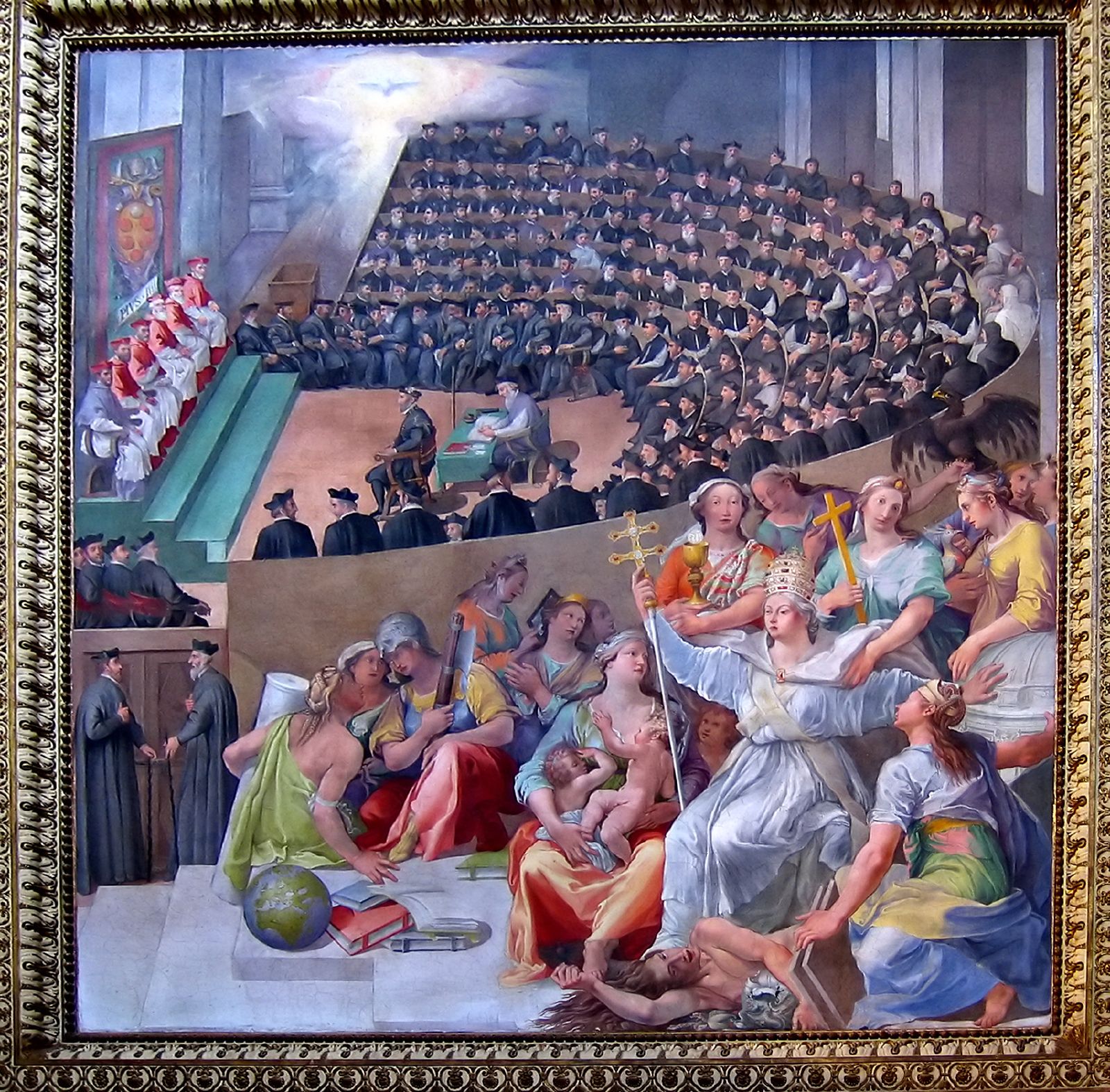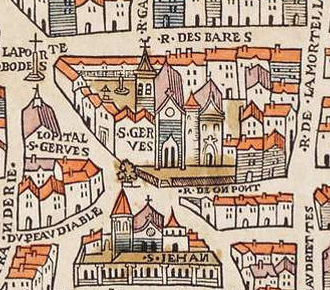|
Saint-Roch, Paris
The Church of Saint-Roch (, ) is a 17th–18th-century French Baroque and classical style church in Paris, dedicated to Saint Roch. It is located at 284 rue Saint-Honoré, in the 1st arrondissement. The current church was built between 1653 and 1740. The church is particularly noted for its very exuberant 18th century chapels decorated with elaborate Baroque murals, sculpture, and architectural detail. In 1795, during the later states of the French Revolution, the front of the church was the site of the 13 Vendémiaire, when the young artillery officer Napoleon Bonaparte fired a battery of cannon to break up a force of Royalist soldiers which threatened the new revolutionary government. History Construction In 1521, the merchant Jean Dinocheau had a chapel built on the outskirts of Paris, which was dedicated to Saint Susanna. In 1577, his nephew Etienne Dinocheau had it extended into a larger church. In the early 18th century, with the beginning of the construction of ... [...More Info...] [...Related Items...] OR: [Wikipedia] [Google] [Baidu] |
Catholic Church
The Catholic Church (), also known as the Roman Catholic Church, is the List of Christian denominations by number of members, largest Christian church, with 1.27 to 1.41 billion baptized Catholics Catholic Church by country, worldwide as of 2025. It is among the world's oldest and largest international institutions and has played a prominent role in the history and development of Western civilization.Gerald O'Collins, O'Collins, p. v (preface). The church consists of 24 Catholic particular churches and liturgical rites#Churches, ''sui iuris'' (autonomous) churches, including the Latin Church and 23 Eastern Catholic Churches, which comprise almost 3,500 dioceses and Eparchy, eparchies List of Catholic dioceses (structured view), around the world, each overseen by one or more Bishops in the Catholic Church, bishops. The pope, who is the bishop of Rome, is the Papal supremacy, chief pastor of the church. The core beliefs of Catholicism are found in the Nicene Creed. The ... [...More Info...] [...Related Items...] OR: [Wikipedia] [Google] [Baidu] |
Jacques Lemercier
Jacques Lemercier (; c. 1585 in Pontoise – 13 January 1654 in Paris) was a French architect and engineer, one of the influential trio that included Louis Le Vau and François Mansart who formed the classicizing French Baroque manner, drawing from French traditions of the previous century and current Roman practice the fresh, essentially French synthesis associated with Cardinal Richelieu and Louis XIII of France, Louis XIII. Life and career Lemercier was born in Pontoise. He was the son of a stonemasonry, master mason, probably Nicolas Lemercier, one of a large interrelated tribe of professionals. Profiting by a voyage to Italy with a long stay in Rome, presumably from about 1607 to 1610, Lemercier developed the simplified classicizing manner established by Salomon de Brosse, who died in 1636, and whose ''Palais du Luxembourg'' for Marie de Medici Lemercier would see to completion. On his return to France, after several years working as an engineer building bridges, his f ... [...More Info...] [...Related Items...] OR: [Wikipedia] [Google] [Baidu] |
Étienne-Louis Boullée
Étienne-Louis Boullée (; 12 February 17284 February 1799) was a visionary French neoclassical architect whose work greatly influenced contemporary architects. Life Born in Paris, he studied under Jacques-François Blondel, Germain Boffrand and Jean-Laurent Le Geay, from whom he learned the mainstream French Classical architecture in the 17th and 18th century and the Neoclassicism that evolved after the mid century. He was elected to the Académie Royale d'Architecture in 1762 and became chief architect to Frederick II of Prussia, a largely honorary title. He designed a number of private houses from 1762 to 1778, though most of these no longer exist; notable survivors into the modern era include the Hôtel de Brunoy (demolished in 1930) and the Hôtel Alexandre, both in Paris. His work for François Racine de Monville has apparently also vanished but his probable influence on Monville's own architectural works as seen at the Désert de Retz speaks for itself. To ... [...More Info...] [...Related Items...] OR: [Wikipedia] [Google] [Baidu] |
Marie Anne De Bourbon
Marie Anne de Bourbon, ''Légitimée de France'', born Marie Anne de La Blaume Le Blanc, by her marriage Princess of Conti then Princess Dowager of Conti, ''suo jure'' Duchess of La Vallière and of Vaujours (; 2 October 1666 – 3 May 1739) was a French noblewoman as the eldest legitimised daughter of Louis XIV, King of France, born from his mistress Louise de La Vallière, and the king's favourite daughter. She married Louis Armand I, Prince of Conti, in 1680 and was widowed in 1685. She never married again and had no issue. Upon her mother's death, she became the ''suo jure'' Duchess of La Vallière and of Vaujours. Early life (1666–1680) Marie-Anne de La Blaume Le Blanc de la Vallière was born 2 October 1666 in the Castle of Vincennes in secret to an unmarried mother, Louise de La Blaume Le Blanc de La Vallière, ''Mademoiselle de La Vallière'' (1644–1710), who had been the mistress of Louis XIV, King of France for about 5 years by then. She had had two full broth ... [...More Info...] [...Related Items...] OR: [Wikipedia] [Google] [Baidu] |
Robert De Cotte
Robert de Cotte (; 1656 – 15 July 1735) was a French architect-administrator, under whose design control of the royal buildings of France from 1699, the earliest notes presaging the Rococo, Rococo style were introduced. First a pupil of Jules Hardouin-Mansart, he later became his brother-in-law and his collaborator. After Hardouin-Mansart's death, de Cotte completed his unfinished projects, notably the royal chapel at Palace of Versailles, Versailles and the Grand Trianon. Biography Born in Paris, Robert de Cotte began his career as a contractor for masonry, working on important royal projects between 1682 and 1685, when he was made a member of the ''Académie royale d'architecture'' and architect of the Court, ranking third in importance after Mansart's seldom-credited assistant François Dorbay. On his return to France after a six-month sojourn in Italy (1689–1690), in the company of Jacques Gabriel, he became the director of the Manufacture des Gobelins, where not o ... [...More Info...] [...Related Items...] OR: [Wikipedia] [Google] [Baidu] |
John Law (economist)
John Law (pronounced in French in the traditional approximation of ''Laws'', the colloquial Scottish form of the name; 21 April 1671 – 21 March 1729) was a Scottish-French economist and financier. He rose to power in France where he created a novel financial scheme for French public finances known as Law's System () with two institutions at its core, John Law's Bank and John Law's Company (also known as the Mississippi company), ending in the devastating boom and bust "Mississippi Bubble" of 1720. Born in Scotland, Law was an accomplished gambler with an interest in the rules of probability. After killing a man in a duel and being sentenced to death, he fled to mainland Europe. He read economics and made the acquaintance of Philippe II, Duke of Orléans, who became regent for the juvenile Louis XV of France in 1715. In 1716 Philippe approved Law's plan to create a private bank which would take gold deposits in return for bank notes, loaning out the gold. It was structured as a ... [...More Info...] [...Related Items...] OR: [Wikipedia] [Google] [Baidu] |
Jules Hardouin-Mansart
Jules Hardouin-Mansart (; 16 April 1646 – 11 May 1708) was a French Baroque architect and builder whose major work included the Place des Victoires (1684–1690); Place Vendôme (1690); the domed chapel of Les Invalides (1690), and the Grand Trianon of the Palace of Versailles. His monumental work was designed to glorify the reign of Louis XIV of France. Biography Born Jules Hardouin in Paris in 1646, he studied under his renowned great-uncle François Mansart, one of the originators of the classical tradition in French architecture; Hardouin inherited Mansart's collection of plans and drawings and added Mansart's name to his own in 1668. He began his career as an entrepreneur in building construction, in partnership with his brother Michel, but then decided in 1672 to devote himself entirely to architecture. In 1674, he became one of the group of royal architects working for Louis XIV. His first important project was the Château de Clagny, built for the King's consort ... [...More Info...] [...Related Items...] OR: [Wikipedia] [Google] [Baidu] |
Council Of Trent
The Council of Trent (), held between 1545 and 1563 in Trent (or Trento), now in northern Italy, was the 19th ecumenical council of the Catholic Church. Prompted by the Protestant Reformation at the time, it has been described as the "most impressive embodiment of the ideals of the Counter-Reformation.""Trent, Council of" in Cross, F. L. (ed.) ''The Oxford Dictionary of the Christian Church'', Oxford University Press, 2005 (). It was the last time an ecumenical council was organized outside the city of Rome. The Council issued key statements and clarifications of the Church's doctrine and teachings, including scripture, the biblical canon, sacred tradition, original sin, justification, salvation, the sacraments, the Mass, and the veneration of saintsWetterau, Bruce. ''World History''. New York: Henry Holt and Company, 1994. and also issued condemnations of what it defined to be heresies committed by proponents of Protestantism. The consequences of the council were als ... [...More Info...] [...Related Items...] OR: [Wikipedia] [Google] [Baidu] |
Church Of The Gesù
The Church of the Gesù (, ), officially named (), is a church located at Piazza del Gesù in the Pigna (rione of Rome), Pigna ''Rioni of Rome, rione'' of Rome, Italy. It is the mother church of the Society of Jesus (best known as Jesuits). With its façade, described as "the first truly Baroque architecture, baroque façade", the church served as a model for innumerable Jesuit churches all over the world, especially in Central Europe and in Portuguese Empire, Portuguese colonies. Its paintings in the nave, Crossing (architecture), crossing, and Side chapel, side chapels became models for art in Jesuit churches throughout Italy and Europe, as well as those of other orders. The Church of the Gesù is one of the great 17th-century preaching churches built by Counter-Reformation orders like the Jesuits in the Centro Storico of Romethe others being Sant'Ignazio, Rome, Sant'Ignazio, also of the Jesuits, San Carlo ai Catinari of the Barnabites, Sant'Andrea della Valle of the Theatines ... [...More Info...] [...Related Items...] OR: [Wikipedia] [Google] [Baidu] |
Saint-Gervais-Saint-Protais
Saint-Gervais-Saint-Protais () is a Roman Catholic parish church located in the 4th arrondissement of Paris, 4th arrondissement of Paris, on Place Saint-Gervais in the Le Marais (Paris), Marais district, east of Hôtel de Ville, Paris, City Hall (Hôtel de Ville). The current church was built between 1494 and 1657, on the site of two earlier churches; the facade, completed last, was the first example of the French Baroque, French baroque style in Paris. The organists of the church included Louis Couperin and his nephew François Couperin, two of the most celebrated composers and musicians of the Baroque period; the organ they used can still be seen today. The church contains remarkable examples of medieval carved choir stalls, stained glass from the 16th century, 17th century sculpture, and modern stained glass by Sylvie Gaudin and Claude Courageux. Saint-Gervais was a parish church until 1975, when it became the headquarters of the Monastic Fraternities of Jerusalem. History A c ... [...More Info...] [...Related Items...] OR: [Wikipedia] [Google] [Baidu] |





